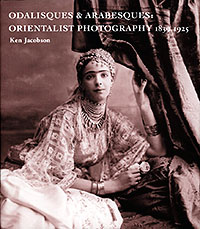Odalisques & Arabesques: Orientalist Photography 1839-1925
By Ken Jacobson
 This book represents the most comprehensive survey to date of nineteenth and early twentieth-century photography of both North Africa and the Middle East. Using Orientalist painting as a counterpoint, the work primarily relates the incredibly rich and beautiful history of visual documentation expressed in the photography of the people, daily life and culture of the Orient. The changes in photographic technology and in aesthetic style are detailed for each decade and important events as well as social and religious practices are interwoven into this history.
This book represents the most comprehensive survey to date of nineteenth and early twentieth-century photography of both North Africa and the Middle East. Using Orientalist painting as a counterpoint, the work primarily relates the incredibly rich and beautiful history of visual documentation expressed in the photography of the people, daily life and culture of the Orient. The changes in photographic technology and in aesthetic style are detailed for each decade and important events as well as social and religious practices are interwoven into this history.
The odalisques of the title were female slaves of the sultan's harem and have been the cause of much mythology. Arabesques, intricate geometric patterns based on flowing lines, usually adorn Eastern art works (due to Islamic traditions prohibiting figurative imagery). The choice of terms possessing a degree of ambiguity is not accidental, but coincides with ambivalent perceptions of imagery of the Near East.
One theme explored is the Western infatuation for Eastern customs and costumes embodied by artists and writers, such as Flaubert and J.F. Lewis, and by photographers like Roger Fenton and Charles Nègre. Though this study is replete with evocative if sometimes unrealistic depictions of people from the Mahgreb and the Levant, the author demonstrates that there also exists a corpus of social documentary photography that often preceded similar studies in the West. A section of this work is devoted to the study of the relationship between the photographer and the artist and reveals for the first time that Jean-Léon Gérôme's famous work, 'The Snake Charmer', borrowed from an Abdullah Frères photograph taken in the Topkapi Palace in Constantinople, and that painters like William Simpson, Renoir and Sargent may have also utilised photographs as copy aids in their Middle Eastern paintings.
The 308 page book is issued in hardback only and contains more than 500 illustrations, a great many of photographs that have never previously been published, including 85 fine full page tritones. There are detailed illustrated biographies of more than 90 photographers as well as a prodigious bibliography. Included among the figures are the stamps, logos, numbering style and signatures of many photographers that now allow the correct attribution of works that have hitherto been anonymous or misattributed. This is one of the first books in which the study of a broad field within photographic history has presented comprehensive visual photographer identification aids for a range of photographic prints that, typically, are infrequently actually signed or stamped with the photographer's name.
Finally, the book questions formulaic postcolonialist interpretations of photographs taken by Western photographers in the East. Though successful photographers may have walked a tightrope along a cusp separating reality and daydream, there is an undeniable frisson between the romantic and the real that is a major part of the appeal of Oriental photography.
Odalisques & Arabesques was shortlisted for the 2008 Kraszna-Krausz award for the best photography book published during the previous two years.
Price: £60 + shipping. Odalisques & Arabesques is available directly from the publisher, Bernard Quaritch, 40 South Audley St., London W1K 2PR UK. Tel. +44 20 7297 4866; email rarebooks@quaritch.com
